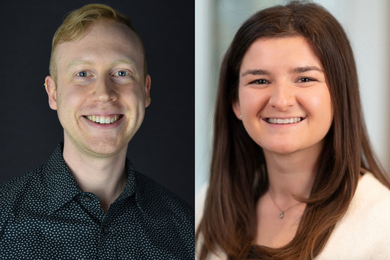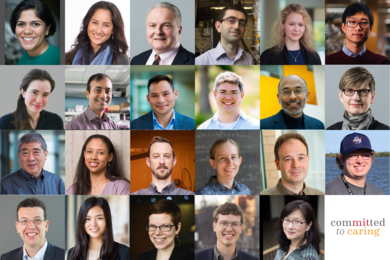When the steamship was introduced, it was known for blowing up. Eventually, however, the technology was perfected, and it largely replaced its predecessor: the sailing boat. The first athletic nutrition bars (such as Power Bars) also had a bad start -- they tasted like sawdust. But with new recipes and their perceived nutritional value and "coolness," they have munched into the confectionery market.
These and other "disruptive" technologies were the focus of last week's 2000 MIT Research Directors Conference sponsored by the Industrial Liaison Program. More than 30 MIT researchers gave tips on how to anticipate, recognize and manage such technologies, and described potentially disruptive technologies in fields from health care to chemicals.
IMPACT ON INDUSTRY
Professor Rebecca M. Henderson introduced the topic by charting how industries evolve, then explained why disruptive technologies create problems for established firms. Dr. Henderson, the George Eastman Kodak Leaders for Manufacturing Professor of Management, also discussed steps for managing the transition to a new technology.
Key to her talk: the so-called "S" curve that describes the life cycle of a firm that's creating or marketing a new technology. The beginning of this curve, she explained, represents the "ferment" stage "when nobody knows quite what's going on." This stage is characterized by an enormous number of new business models or approaches. For example, in the early stage of the automobile, some vehicles were powered by coal or wood. The Internet is currently in the ferment stage, she said.
Eventually, however, people figure out what works, and "that starts the golden era of a company -- the era of takeoff" when it grows very quickly. By maturity -- the top of the curve -- a company has become very good at what it does and is quite strong.
But at that point, "when something changes, you're in trouble," Professor Henderson said. The reason: companies need different kinds of people and skills at different stages of their life cycles. "So it's hugely difficult [for an established firm] to move from one generation of technology to another."
To aid this process, it's critical for a company to know its sources of competitive advantage, such as name recognition or a fabulous sales crew. The reason: "Many of the competitive advantages that sustain a company become obsolete, but not all," Professor Henderson said. "Some of the assets you have will be useful in moving to the next 'S' curve."
So the first step in developing a business model for a disruptive technology is to determine which of a company's core competencies will work with the new technology and which won't. "In my experience, recognizing your strengths and determining which should be applied to the new venture is the single most important thing you can do" in managing a disruptive technology, Professor Henderson said.
Companies that have "managed a number of very successful transitions," she said, include Hewlett-Packard, which moved from calculators to computers to medical equipment; Johnson and Johnson; and Sony.
GUARDIAN ANGEL
Six concurrent afternoon sessions explored disruptive technologies in transportation and logistics, life science and health care, communications and computing, chemicals and materials, energy markets, and manufacturing.
In the life science/health care session Professor Peter Szolovits described the Guardian Angel -- a computerized information system that will allow patients to track their health history. The idea is "to engage the patient in his or her own care," said Professor Szolovits of the Department of Electrical Engineering and Computer Science. After all, he said, "you are the person most concerned about your health."
Among other advantages, the system would contain "an individualized medical encyclopedia that explains [test] results and plans to the patient." It would also include personal notes from the doctor, such as instructions for follow-up care.
The latter was tested last year in a program called Health Connect based at Childrens' Hospital in Boston. In the six-week pilot, two doctors discharged patients using the system, which was accessible by the Internet. Some 201 patients took advantage of the system, which included the option to send e-mail questions to the doctor (47 did so).
Professor Szolovits addressed the fact that not everyone has access to the web. "Yes, there is a social disparity," he said. "The more money you have, the more likely you have e-mail and Internet access." However, he said, access is increasing rapidly; he noted that one homeless woman participated in the pilot. "She told us, 'This is great. They just installed the Internet in the shelter and now I have a reason to use it.'"
This fall, 100 newborns will begin a second program -- the Personal Internetworked Notary and Guardian. PING "is basically a data sponge," Professor Szolovits said. The idea is to keep a patient's complete health record in computerized form from birth.
DETECTING TOXINS
The application of engineered tissue to the detection of toxins was the focus of a talk by Linda G. Griffith, associate professor of chemical engineering and bioengineering. Professor Griffith described how a team of about a dozen MIT researchers is growing 3-D samples of liver in microscopic channels in a silicon chip. The chip, in turn, is placed in a bioreactor where the samples grow.
"Currently we've got a bioreactor system that maintains the liver in a functional state," she said. "We're now starting to apply [the liver system] to detecting toxins." Ultimately the team expects to use spectroscopy, or fluorescence, to show how the tissue changes in response to the addition of toxins or other substances.
A version of this article appeared in MIT Tech Talk on May 17, 2000.





